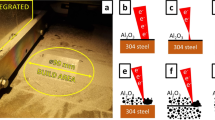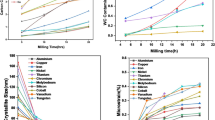Abstract
The results of the investigation into the formation of amorphous structures in the Cu–Ti system and their subsequent crystallization under the effect of high-energy ball milling (HEBM) are presented. To form amorphous Cu–Ti powders, powders of copper (MPS-V grade with average particle size d = 45–100 μm, GOST (State Standard) 4960–75) and titanium (PM99.95, d = 2.0–4.5 μm, TU (Technical Specifications) 48-19-316–80) are selected as the initial components. The HEBM of Cu + Ti powder mixtures is performed using an Aktivator-2S laboratory planetary ball mill (at revolution rates of discs of 694 rpm and drums of 1388 rpm) for 1–30 min. The investigations into the surface morphology and micro-, nano-, and atomic crystalline structure of activated Cu + Ti powder mixtures are fulfilled by X-ray structural analysis (XSA) using a DRON-3M diffractometer, scanning electron microscopy using a Zeiss Ultra+ microscope (Germany) with the application of energy dispersive analysis, and high-resolution transmission electron microscopy (TEM) using a Titan microscope (United States). The determination of thermal characteristics of phase transformations (temperature, heat of reaction, and amorphous-to-crystalline transition) are performed by differential scanning calorimetry using a DSC 204 F1 device in the mode of linear heating to 450°C at a rate of 20 K/min. The Cu–Ti amorphous powders were fabricated using HEBM for 20 min. The XSA data evidence that the fraction of the amorphous phase in the material was 93%. The TEM investigations showed that the material preferentially consists of the amorphous phase with an insignificant content of nanocrystalline regions 2–8 nm in size. It is found that the Cu–Ti amorphous phase crystallizes in a temperature range of 336–369°C, and the heat of reaction is 79.78 J/g.







Similar content being viewed by others
REFERENCES
Willens, R.H., Klement, W., and Duwez, P., Continuous series of metastable solid solutions in silver-copper alloys, J. Appl. Phys., 1960, vol. 31, pp. 1136–1137.
Sudzuki, K., Hudzumori, H., and Hasimoto, K., Amorfnye metally (Amorphous Metals), Moscow: Metallurgiya, 1987.
Davidson, M., Roberts, S., Castro, G., Dillon, R.P., Kunz, A., Kozachkov, H., Demetriou, M.D., Johnson, W.L., Nutt, S., and Hofmann, D.C., Investigating amorphous metal composite architectures as spacecraft shielding, Adv. Eng. Mater., 2013, vol. 15, nos. 1–2, pp. 27–33.
Johnson, W.L., Bulk metallic glasses—a new engineering material, Met. Alloys, 1996, vol. 1, pp. 383–386.
Zolotukhin, I.V., Amorphous metallic materials, Soros. Obraz. Zh., 1997, no. 4, pp. 73–78.
Pozdnyakov, V.A., Fizicheskoe materialovedenie nanostrukturirovannykh materialov (Physical Materials Science of Nanostructured Materials), Moscow: MGIU, 2007.
Brunelli, K., Dabala, M., Frattini, R., Sandona, G., and Calliari, I., Electrochemical behaviour of Cu–Zr and Cu–Ti glassy alloys, J. Alloys Compd., 2001, nos. 317–318, pp. 595–602.
Pineda, E., Bruna, P., Ruta, B., Gonzalez-Silveira, M., and Crespo, D., Relaxation of rapidly quenched metallic glasses: Effect of the relaxation state on the slow low temperature dynamics, Acta Mater., 2013, vol. 61, pp. 3002–3011.
Kobayashi, A., Yano, S., Kimura, H., and Inoue, A., Fe-based metallic glass coatings produced by smart plasma spraying process, Mater. Sci. Eng. B, 2008, vol. 148, nos. 1–3, pp. 110–113.
Marikani, A., Engineering Physics, New Delhi: Ray, 2013, 2nd ed.
Shekhar, K.M. and Nageswar, S., Electrodeposition of copper on Cu–Zr metallic glass substrates, J. Appl. Electrochem., 1988, vol. 18, no. 2, pp. 200–204.
Blanquet, E., Mantoux, A., Pons, M., and Vahlas, C., Chemical vapor deposition and atomic layer deposition of amorphous and nanocrystalline metallic coatings: towards deposition of multimetallic films, J. Alloys Compd., 2010, vol. 504, pp. 422–424.
Sun, H. and Flores, K.M., Laser deposition of a Cu-based metallic glass powder on a Zr-based glass substrate, J. Mater. Res., 2008, vol. 23, no. 10, pp. 2692–2703.
Koch, C., Cavin, O.B., McKamey, C.G., and Scarbrough, J.O., Preparation of amorphous Ni60Nb40 by mechanical alloying, Appl. Phys. Lett., 1983, vol. 43, pp. 1017–1019.
Politis, C., Nanostructured and amorphous materials by mechanical alloying, Chin. Phys., 2001, vol. 10, pp. 31–35.
Shkodich, N.F., Rogachev, A.S., Vadchenko, S.G., Moskovskikh, D.O., Sachkova, N.V., Rouvimov, S., and Mukasyan, A.S., Bulk Cu-Cr nanocomposites by high-energy ball milling and spark plasma sintering, J. Alloys Compd., 2014, vol. 617, pp. 39–46.
Pourfereidouni, A. and Akbari, G.H., Development of nanostructure Cu–Ti alloys by mechanical alloying process, Adv. Mater. Res., 2014, vol. 829, pp. 168–172.
Politis, C. and Johnson, W.L., Preparation of amorphous TiCux (0.10 < x < 0.87) by mechanical alloying, Appl. Phys., 1986, vol. 60, no. 3, pp. 1147–1151.
Molnar, A., Domokos, L., Katona, T., Martinek, T., Mulas, G., Cocco, G., Bertoti, I., and Szepvolgyi, J., Activation of amorphous Cu–M (M–Ti, Zr, or Hf) alloy powders made by mechanical alloying, Mater. Sci. Eng., 1997, nos. 226–228, pp. 1074–1078.
Savin, V.V. and Chaika, V.A., Formation of amorphous powders of alloys of the Cu–Ti system with mechanical activation of powder mixtures, Powder Metall. Met. Ceram., 1998, vol. 37, no. 7, pp. 448–457.
Guwer, A., Nowosielski, R., Borowski, A., and Babilas, R., Fabrication of copper–titanium powders prepared by mechanical alloying, Indian J. Eng. Mater. Sci., 2014, vol. 21, pp. 265–271.
Hirooka, Y., Thermal decomposition of titanium hydride and its application to low pressure hydrogen control, J. Vacuum Sci. Technol. A, 1984, vol. 2, pp. 16–21.
Lehmhus, D. and Rauch, G., Tailoring titanium hydride decomposition kinetics de annealing in various atmospheres, Adv. Eng. Mater., 2004, vol. 6, no. 5, pp. 313–330.
Duan, G., Wiest, A., Lind, M.L., Kahl, A., and Johnson, W.L., Lightweight Ti-based bulk metallic glasses excluding late transition metals, Scripta Mater., 2008, vol. 58, pp. 465–468.
Baricco, M., Battezzati, L., Soletta, I., Schiffini, L., and Cowlam, N., Thermal behavior of Cu–Ti and Cu–Ti–H amorphous powders prepared by ball milling, Mater. Sci. Eng. A, 1991, vol. 134, pp. 1398–1401.
Rogachev, A.S., Shkodich, N.F., Vadchenko, S.G., Baras, F., Kovalev, D.Yu., Rouvimov, S., Nepapushev, A.A., and Mukasyan, A.S., Influence of the high energy ball milling on structure and reactivity of the Ni + Al powder mixture, J. Alloys Compd., 2013, vol. 577, pp. 600–605.
ACKNOWLEDGMENTS
We thank A.S. Shchukin for photographs of the Cu–Ti microstructure recorded using a scanning electron microscope and presented at our disposal.
This study was supported by the Russian Scientific Foundation, agreement on the grant representation no. 16-13-10431.
Author information
Authors and Affiliations
Corresponding authors
Additional information
Translated by N. Korovin
About this article
Cite this article
Shkodich, N.F., Rogachev, A.S., Vadchenko, S.G. et al. Formation of Amorphous Structures and Their Crystallization in the Cu–Ti System by High-Energy Ball Milling. Russ. J. Non-ferrous Metals 59, 543–549 (2018). https://doi.org/10.3103/S1067821218050176
Received:
Accepted:
Published:
Issue Date:
DOI: https://doi.org/10.3103/S1067821218050176




